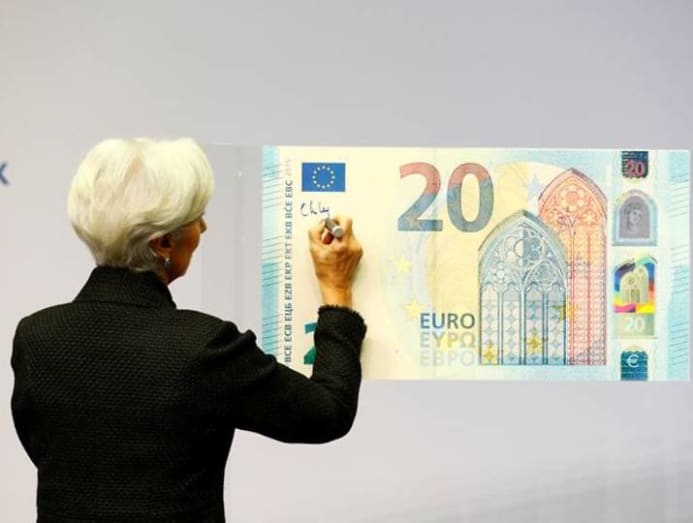commentary Commentary
Commentary: Unclear if rebound shows economic recovery or a sign of persistent inflation
But over the next few years, loose monetary and fiscal policies could trigger persistent inflationary pressure, says Nouriel Roubini.

A man looks at a shopwindow of a cookie store, as non-essential stores prepare to reopen after weeks of lockdown to combat a resurgence of the coronavirus disease (COVID-19) outbreak, in Paris France, November 27, 2020. A poster reads '"It is open". REUTERS/Charles Platiau/Files
NEW YORK CITY: There is a growing debate about whether the inflation that will arise over the next few months will be temporary, reflecting the sharp bounce back from the COVID-19 recession, or persistent, reflecting both demand-pull and cost-push factors.
Several arguments point to a persistent secular increase in inflation, which has remained below most central banks’ annual 2 per cent target for over a decade.
The first holds that the United States has enacted excessive fiscal stimulus for an economy that already appears to be recovering faster than expected. The additional US$1.9 trillion of spending approved in March came on top of a US$3 trillion package last spring and a US$900 billion stimulus in December, and a US$2 trillion infrastructure bill will soon follow.
The US response to the crisis is thus an order of magnitude larger than its response to the 2008 global financial crisis.
READ: Commentary: Biden’s big fiscal gamble on America’s future
READ: Commentary: Joe Biden’s quietly revolutionary first 100 days
The counter-argument is that this stimulus will not trigger lasting inflation, because households will save a large fraction of it to pay down debts. Moreover, investments in infrastructure will increase not just demand but also supply, by expanding the stock of productivity-enhancing public capital.
But, of course, even accounting for these dynamics, the bulge of private savings brought by the stimulus implies that there will be some inflationary release of pent-up demand.
CENTRAL BANKS CAN COMBAT STAGFLATION
A second, related argument is that the US Federal Reserve and other major central banks are being excessively accommodative with policies that combine monetary and credit easing. The liquidity provided by central banks has already led to asset inflation in the short run, and will drive inflationary credit growth and real spending as economic re-opening and recovery accelerate.
Some will argue that when the time comes, central banks can simply mop up the excess liquidity by drawing down their balance sheets and raising policy rates from zero or negative levels. But this claim has become increasingly hard to swallow.
Centrals banks have been monetising large fiscal deficits in what amounts to “helicopter money” or an application of Modern Monetary Theory.
READ: Commentary: We need to talk about how Donald Trump’s presidency wasn’t a complete disaster

At a time when public and private debt is growing from an already high baseline (425 per cent of GDP in advanced economies and 356 per cent globally), only a combination of low short- and long-term interest rates can keep debt burdens sustainable.
Monetary policy normalisation at this point would crash bond and credit markets, and then stock markets, inciting a recession. Central banks have effectively lost their independence.
Here, the counter-argument is that when economies reach full capacity and full employment, central banks will do whatever it takes to maintain their credibility and independence. The alternative would be a de-anchoring of inflation expectations that would destroy their reputations and allow for runaway price growth.
READ: Commentary: Central banks are falling in line in fight against climate change
FISCAL DEFICITS WILL PREVENT DEFLATION
A third claim is that the monetisation of fiscal deficits will not be inflationary; rather, it will merely prevent deflation. However, this assumes that the shock hitting the global economy resembles the one in 2008, when the collapse of an asset bubble created a credit crunch and thus an aggregate demand shock.
The problem today is that we are recovering from a negative aggregate supply shock. As such, overly loose monetary and fiscal policies could indeed lead to inflation or, worse, stagflation (high inflation alongside a recession).
After all, the stagflation of the 1970s came after two negative oil-supply shocks following the 1973 Yom Kippur War and the 1979 Iranian Revolution.
READ: Commentary: Oil set for a long and rocky road to recovery
READ: Commentary: US proposed global minimum corporate tax has implications for Singapore
In today’s context, we will need to worry about a number of potential negative supply shocks, both as threats to potential growth and as possible factors driving up production costs.
These include trade hurdles such as de-globalisation and rising protectionism; post-pandemic supply bottlenecks; the deepening Sino-American cold war; and the ensuing balkanisation of global supply chains and reshoring of foreign direct investment from low-cost China to higher-cost locations.
Equally worrying is the demographic structure in both advanced and emerging economies. Just when elderly cohorts are boosting consumption by spending down their savings, new restrictions on migration will be putting upward pressure on labour costs.

Moreover, rising income and wealth inequalities mean that the threat of a populist backlash will remain in play. On one hand, this could take the form of fiscal and regulatory policies to support workers and unions – a further source of pressure on labour costs.
On the other hand, the concentration of oligopolistic power in the corporate sector also could prove inflationary, because it boosts producers’ pricing power.
And, of course, the backlash against Big Tech and capital-intensive, labour-saving technology could reduce innovation more broadly.
READ: Commentary: The brewing discontent with trade and one step to restoring faith in globalisation
PREVENTING A SUSTAINED INFLATIONARY SURGE
There is a counter-narrative to this stagflationary thesis. Despite the public backlash, technological innovation in artificial intelligence, machine learning, and robotics could continue to weaken labour, and demographic effects could be offset by higher retirement ages (implying a larger labour supply).
Similarly, today’s reversal of globalisation may itself be reversed as regional integration deepens in many parts of the world, and as the outsourcing of services provides workarounds for obstacles to labour migration (a programmer in India doesn’t have to move to Silicon Valley to design a US app).
Finally, any reductions in income inequality may simply militate against tepid demand and deflationary secular stagnation, rather than being severely inflationary.
READ: Commentary: What the stuck ship in the Suez Canal taught us about life
In the short run, the slack in markets for goods, labour, and commodities, and in some real estate markets, will prevent a sustained inflationary surge.
But over the next few years, loose monetary and fiscal policies will start to trigger persistent inflationary – and eventually stagflationary – pressure, owing to the emergence of any number of persistent negative supply shocks.
Make no mistake: Inflation’s return would have severe economic and financial consequences. We would have gone from the “Great Moderation” to a new period of macro instability.
The secular bull market in bonds would finally end, and rising nominal and real bond yields would make today’s debts unsustainable, crashing global equity markets. In due time, we could even witness the return of 1970s-style malaise.
Nouriel Roubini, Professor of Economics at New York University’s Stern School of Business, is host of the NourielToday.com broadcast.





